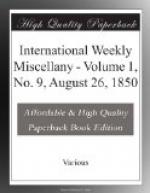The law of Mahometan jurists is for India pretty much what the Roman law is for Scotland and the Continental nations of Europe. Savigny has shown how, throughout all the territories formerly included within the limits of the Roman Empire, a large amount of Roman legal doctrines and forms of procedure continued to be operative after the Empire’s subversion. The revival of the study of the Roman law, as embodied in the compilations of Justinian, by the doctors of the school of Bologna, augmented and systematized these remnants of Roman jurisprudence, and extended their application to countries which (like great part of Germany) had never been subjected to the sway of Rome. In like manner, throughout that part of India which was permanently subdued and organized by the Mogul dynasty, and also those parts in which minor Islamitic states were established, the organization of the courts of justice, and the legal opinions of the individuals who officiated in them, necessarily introduced a large amount of Mahometan jurisprudence. This element of the law of India was augmented and systematized by the writings of private jurists, and by compilations undertaken by command of princes. As with the Roman jurisprudence in Europe, so with Mahometan jurisprudence in India, only so much of its doctrines and forms could at any time be considered to possess legal force as had been reenacted by the local sovereigns, or introduced by judges in the form of decisions. A systematic knowledge of the whole body of Mahometan law was important to the Indian lawyer, as enabling him more thoroughly to understand the system, and its various isolated doctrines; but the whole body of that law was at no time binding in India. Since the establishment of British sway, only so much of the Mahometan law as has kept its ground in the practice of the courts, or has been reenacted by the “regulations” or “ordinances” of the Anglo-Indian Government, is law; the rest is only valuable as the “antiquities of the law,” which help to trace the origin of what survives, and thereby throw light upon what in it is obscure or doubtful.
Among the most valuable, if not indeed the most valuable of the compilations from which we may obtain a knowledge of Mahometan jurisprudence, is the “Futawa Alumgeeree,” mentioned in Mr. Baillie’s title-page. Its value is not confined to the purposes of those who would make themselves acquainted with Mahometan jurisprudence in the peculiar form it assumed in India. It is highly esteemed throughout Islam, and is quoted even by the doctors of Mecca as the Futawa-i-hind, or the Indian responsa prudentum. It was compiled by the orders of the Emperor Aurungzebe. It is a digest of the “Futawa” of the most celebrated jurists of the Hanifeh (or, as Mr. Baillie spells it, Hunefeeah) sect or school. Mr. Baillie informs us in his preface, that “futawa is the plural form of futwa, a term in common use in Mahometan countries to signify an exposition




